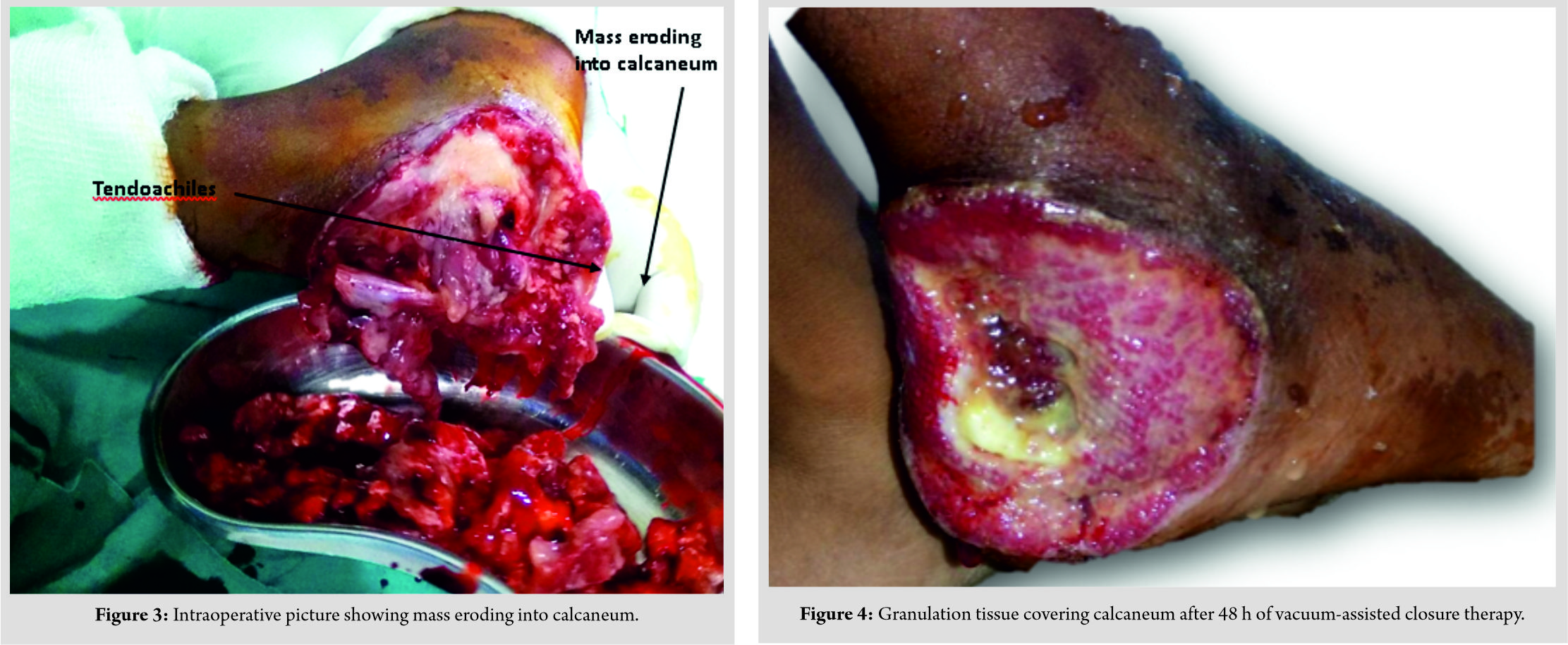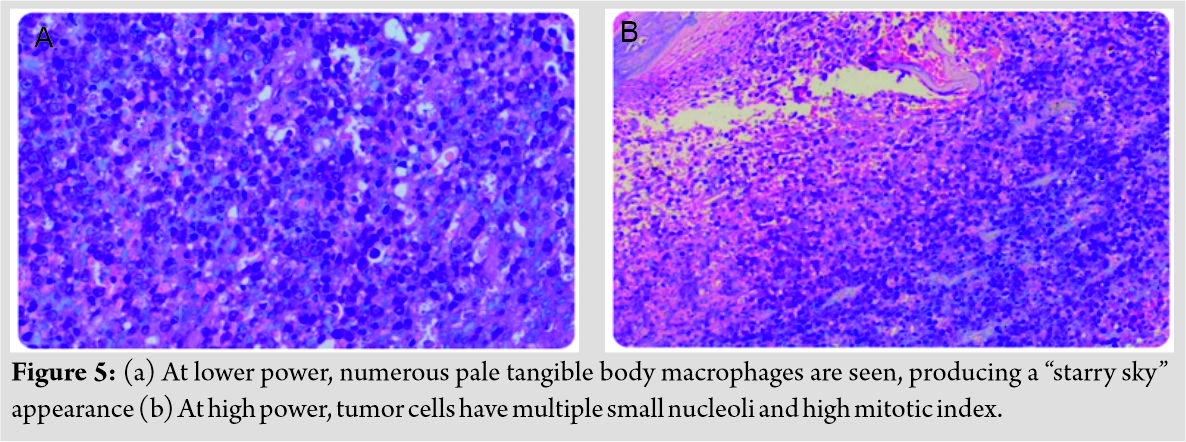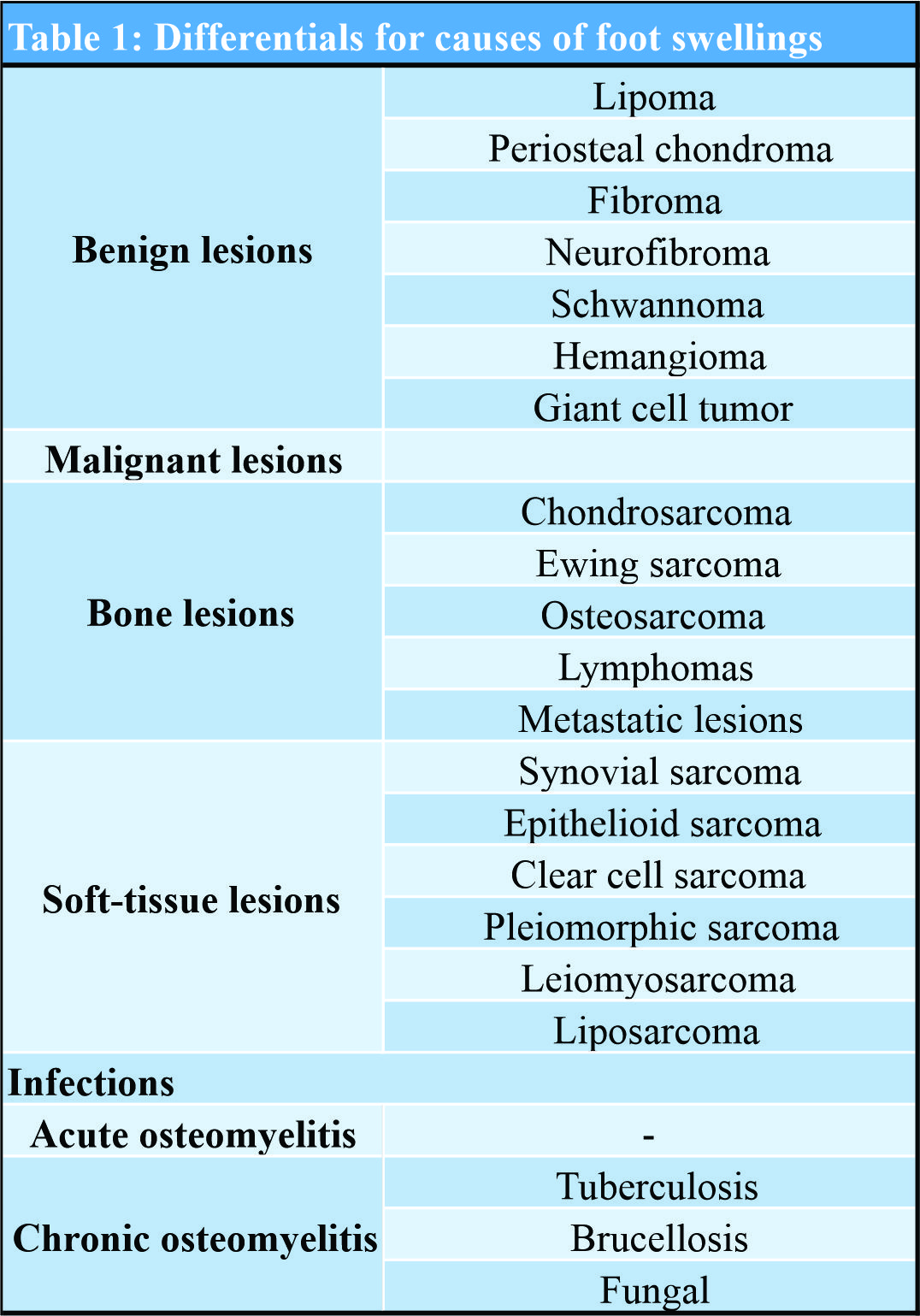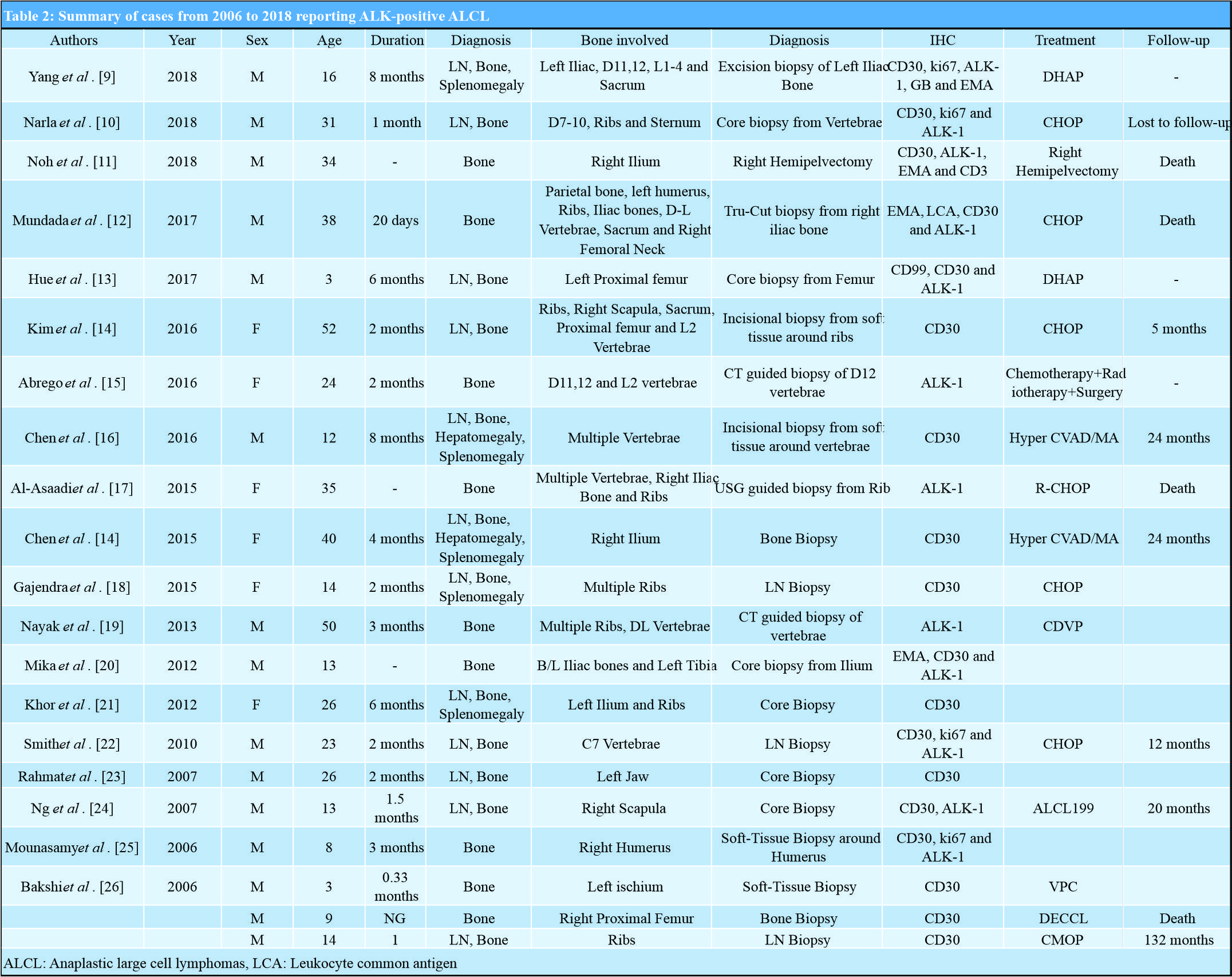[box type=”bio”] Learning Point of the Article: [/box]
Aggressive fungating lesions which start as swelling over foot in a child can be a very unrelated hematological malignancy instead of any local neoplasm or infection.
Case Report | Volume 9 | Issue 4 | JOCR July-August 2019 | Page 14-18 | Sitanshu Barik, Nikhil Goyal, Souvik Paul, Vivek Singh, Shobha Arora. DOI: 10.13107/jocr.2019.v09i04.1458
Authors: Sitanshu Barik[1], Nikhil Goyal[1], Souvik Paul[1], Vivek Singh[1], Shobha Arora[1]
[1]Department of Orthopedics, All India Institute of Medical Sciences, Rishikesh, Uttarakhand, India.
Address of Correspondence:
Dr. Sitanshu Barik,
Room 112, SR Hostel, All India Institute of Medical Sciences, Rishikesh, Uttarakhand, India.
E-mail: sitanshubarik@gmail.com
Abstract
Introduction: Primary bone lymphomas are rare, and primary anaplastic large cell lymphomas (ALCLs) of bone in a child are even rarer. A case of primary ALCL of calcaneus in a 7-year-old child is presented.
Case Report: Child aged 7 years presented with fungating swelling over his right heel which was associated with fever. The diagnosis was established by immunohistochemistry (CD30, ALK) of the biopsied specimen. Treatment was done by chemotherapy and subsequent radiotherapy. At 12-month follow-up, the child was ambulant with complete resolution of the swelling.
Conclusion: Masses arising from the foot and ankle can be a diagnostic challenge, and both infection and neoplasm should be considered in its differentials.
Keywords: Bone, lymphoma, anaplastic MeSH terms: Lymphoma, large cell, anaplastic, calcaneus.
Introduction
Lymphomas are a heterogeneous group of neoplasms arising from lymphocytes which can be nodal as well as extranodal. Osseous extranodal lymphoma is a rare entity which comprises around 5% of all primary bone tumors [1]. The femur, tibia, and pelvis are the most common sites of primary bone lymphoma (PBL). A few case reports of PBL in the foot have been described in adults which are histologically diffuse B-cell lymphoma [2, 3, 4, 5]. We present a rare case of anaplastic large cell lymphoma (ALCL) affecting the calcaneus in a 7-year-old child.
Case Report
A 7-year-old male child presented with swelling and pain in the outer aspect of the right heel for past 1 month. Mother of the child correlated the swelling with a history of trivial trauma. The swelling was gradually progressing. A history of incision and drainage of swelling by a local practitioner after 5 days of onset of swelling was noted. There was an associated history of high-grade fever of insidious onset, intermittent in nature with chills and without any diurnal variation. Constitutional symptoms such as significant weight loss, loss of appetite, and malaise were present for the past 2 weeks. He was unable to walk or weight bear due to pain in right lower limb for the past 1 week. The patient was febrile and having tachycardia at presentation. No lymphadenopathy was detected clinically. A swelling of 5*4*2 cm size which was tender was present over the posterolateral aspect of heel extending anteriorly covering lateral malleolus, posteriorly extending to the area of tendoachilles insertion to the calcaneus, superiorly 5 cm above whole of the lateral malleolus, and inferiorly 2 cm above the heel (Fig. 1). It had an irregular surface, well-defined round margins with loss of skin cover in more than 50% of the surface area with reddish brown color. There was active oozing of blood from the superior and inferior edge of the swelling. Temperature around swelling was raised. Lateral malleolus was not separately palpable from swelling. Tendoachilles could be separately palpable. Ankle motion was restricted and painful with no distal neuro deficits.
X-ray showed large soft-tissue shadow over heel with loss of soft-tissue planes and a lytic lesion over the posterior aspect of the calcaneus with destruction of the posterior tuberosity of calcaneus (Fig. 2a). Magnetic resonance imaging showed a lobulated well-defined mass of size 5*3.5*6 cm in the posterolateral aspect of the ankle with hyperintensity in T2 and T1 images (Fig. 2b-e). The mass invaded calcaneus posteriorly with encasement of tendoachilles. Peroneal tendons were free. Diagnosis of soft-tissue sarcoma was made.
The initial two core biopsies were non-confirmatory, one of which showed features of acute inflammation with no evidence of malignancy. Aerobic, non-aerobic, or fungal cultures were negative. The swelling increased in size and turned into a fungating mass with sloughs hanging from the surface within 2-week duration after the presentation (Fig. 1). An excisional biopsy of the swelling finally showed features suggestive of non-Hodgkin’s lymphoma. The tumor mass was found to be eroding into the posterior aspect of calcaneum with the involvement of the insertion site of tendoachilles (Fig. 3).

Staging of the patient was done by ruling out any synchronous or metachronous disease elsewhere by doing CT scan of chest and abdomen and bilateral bone marrow biopsy. Hence, a diagnosis of PBL with a histological diagnosis of ALCL was made. Treatment was carried out as advised by the oncology team, with 3 cycles of chemotherapy (CHOP – cyclophosphamide, doxorubicin, vincristine, and prednisone) followed by 5 cycles of localized radiotherapy. Supportive treatment in terms of prevention of anemia and infection was given. He did not have any presentation of any diseased lymphadenopathy or organomegaly during the course of treatment. At the last follow-up at 12 months, the wound over the posterior aspect had healed with the patient being ambulatory.
Discussion
Diagnosis of a swelling or fungating growth of the foot in a child can be a diagnostic challenge. Acute as well as chronic osteomyelitis along with benign and malignant lesions can present with such a scenario which can be ruled out by clinical features, laboratory investigations, and confirmed by a tissue diagnosis. The differentials for the malignant and benign conditions are presented (Table 1).
PBL is defined as (1) a single bone lesion, with or without the involvement of regional lymph nodes and (2) multiple bone lesions without lymph nodal or visceral diseases [6]. The case presented is rare in terms of the age of presentation, the location of the mass as well as the histological diagnosis. The PBLs of foot and ankle that have been reported in the literature were in adults [2, 3, 4, 5]. The histological peculiarity of this case was in terms of ALCL which was ALK positive.
ALCL is the most common T-cell neoplasm in children and adolescents. ALCL primarily involves lymph nodes with extranodal involvement of skin, soft tissue, or lung with primary involvement of bone being rare. ALCL has been divided further by the WHO into – (1) ALK-positive, (2) ALK-negative, and (3) primary cutaneous ALCL. Most of the ALCL presenting in children are ALK-positive. They also mimic as non-lymphomatous lesions. Case reports of being initially diagnosed as neuroblastoma or rhabdomyosarcoma are present [7]. They usually present at an advanced stage of disease with frequent extranodal involvement. Cases of primary bone ALCL have been reported [8]. The diagnosis is primarily based on immunohistochemistry with CD30 positivity. In a review of literature of ALK-positive ALCL with bony involvement, none of the cases reported were involving hand or foot (Table 2) [9-26]. The common sites involved were spine, pelvis, and femur. To date, the most effective treatment has been chemotherapy using CHOP regimen. Surgery is indicated for a destructive lesion in a weight-bearing bone or any pathological fracture. Irradiation therapy alone or in conjunction with chemotherapy has not shown improvement of overall survival in a mono-ostotic disease [11].
Conclusion
PBL and more precisely, primary ALCL in bone is rare in younger age group. The common site involved is axial skeleton. A high degree of suspicion with good pathological support is required to make a diagnosis of ALCL at uncommon sites. ALK-positive ALCL has shown to have good remission rates to chemotherapy.
Clinical Message
Fungating mass over the heel with lytic expansile lesion over the calcaneum is an enigma in pediatric population. Neoplastic as well as infective conditions both typical and atypical should be considered in the differentials in the workup of such a case. Histopathological examination holds the key in such cases.
References
1. Freeman C, Berg JW, Cutler SJ. Occurrence and prognosis of extranodal lymphomas. Cancer 1972;29:252-60.
2. Bansal S, Dharra N. Primary malignant non-hodgkin lymphoma of the talus. J Cancer Res Ther 2015;11:649.
3. Singh DP, Dhillon MS, Sur RK, Sharma SC, Radotra BD. Primary lymphoma of the bones of the foot: Management of two cases. Foot Ankle 1991;11:314-6.
4. Blume P, Charlot-Hicks F, Mohammed S. Case report and review of primary bone diffuse large B-cell lymphoma involving the calcaneus. J Foot Ankle Surg 2013;52:666-72.
5. White LM, Siegel S, Shin SS, Weisman MH, Sartoris DJ. Primary lymphoma of the calcaneus. Skeletal Radiol 1996;25:775-8.
6. Santini-Araujo E, Kalil RK, Bertoni F, Park YK. Tumors and Tumor-Like Lesions of Bone. Verlag, London, United Kingdom: Spinger; 2015. p. 385-411.
7. Gustafson S, Medeiros LJ, Kalhor N, Bueso-Ramos CE. Anaplastic large cell lymphoma: Another entity in the differential diagnosis of small round blue cell tumors. Ann Diagn Pathol 2009;13:413-27.
8. Tian C, Wang Y, Zhang Y. ALK-positive anaplastic large cell lymphoma with prominent bone involvement. Br J Haematol 2015;170:443.
9. Yang Y, Xie Q, Liu Y, Chen Y, Yin G. ALK-positive anaplastic large cell lymphoma with multifocal bone involvements: A case report and review of the literature. Int J Clin Exp Med 2018;11:2745-51.
10. Narla SL, Kurian AJ, Subramanyan A, Parameswaran A. ALK-1 positive anaplastic large cell lymphoma presenting as extensive and exclusive osseous involvement: Report of a rare association and review of literature. J Clin Diagn Res 2018;12:ED01-3.
11. Noh BJ, Han CS, Park JS, Lee J, Kim YW, Park YK, et al. ALK-positive anaplastic large-cell lymphoma with primary bone involvement: A rare case and review of the literature. Malays J Pathol 2018;40:161-7.
12. Mundada M, Ahmed F, Santa A. A challenging case of anaplastic large cell lymphoma with primary bony presentation. Asian J Oncol 2017;3:155-7.
13. Hue SS, Iyer P, Toh LH, Jain S, Tan EE, Sittampalam K, et al. Primary bone anaplastic large cell lymphoma masquerading as Ewing sarcoma: Diagnosis by anchored multiplex PCR. J Pediatr Hematol Oncol 2017;40:e105-7.
14. Kim KH, Jung YH, Han CW, Woo IS, Son JH. A case of primary bone anaplastic large cell lymphoma. Am J Case Rep 2016;17:734-8.
15. Abrego G, García J, Gilbert B, Forseen S, Toscano M. ALK positive anaplastic large cell lymphoma of the thoracic spine. J Radiol Case Rep 2016;10:1-2.
16. Tian C, Yu Y, Yang H, Zhu L, Wang Y, Zhang Y, et al. ALK-positive anaplastic large cell lymphoma with prominent bone involvement in a 13-year-old boy. Onco Targets Ther 2016;9:265-8.
17. Al-Asaadi Z, Fatin S, Patel K, Chetty N, Dubrey S. Anaplastic large cell lymphoma with axial skeletal lesions portends a poor prognosis. Br J Hosp Med (Lond) 2015;76:606-7.
18. Gajendra S, Sachdev R, Lipi L, Goel S, Misra R. ALK positive anaplastic large cell lymphoma presenting as extensive bone involvement. J Clin Diagn Res 2015;9:XD04-XD05.
19. Nayak HK, Nishant R, Sinha NK, Daga MK. Anaplastic large T-cell lymphoma presenting as an isolated osseous involvement: A case report and review of the literature. BMJ Case Rep 2013;2013:bcr2013009308.
20. Mika J, Schleicher I, Gerlach U, Adler CP, Uhl M, Knoeller SM, et al. Primary bone lymphomas thought to be osteomyelitis urgently demand a rapid diagnosis in bone pathology. Anticancer Res 2012;32:4905-12.
21. Khor LK, Wang S, Lu SJ. Anaplastic large cell lymphoma of the vertebra masquerading as tuberculous spondylitis: Potential pitfalls of conventional imaging. Intern Emerg Med 2012;7:573-7.
22. Smith ZA, Sedrak MF, Khoo LT. Primary bony non-hodgkin lymphoma of the cervical spine: A case report. J Med Case Rep 2010;4:35.
23. Rahmat K, Wastie M, Abdullah B. Primary bone lymphoma: Report of a case with multifocal skeletal involvement. Biomed Imaging Interv J 2007;3:e52.
24. Ng A, Hobson R, Williams D, Morland B. Anaplastic large cell lymphoma of bone is it a bad tumor? Pediatr Blood Cancer 2007;48:473-6.
25. Mounasamy V, Berns S, Azouz EM, Giusti V, Knapp DR. Anaplastic large cell lymphoma presenting as an epiphyseal lytic lesion a case report with clinico-pathologic correlation. Skeletal Radiol 2006;35:619-23.
26. Bakshi NA, Ross CW, Finn WG, Valdez R, Ruiz R, Koujok K, et al. ALK-positive anaplastic large cell lymphoma with primary bone involvement in children. Am J Clin Pathol 2006;125:57-63.
 |
 |
 |
 |
 |
| Dr. Sitanshu Barik | Dr. Nikhil Goyal | Dr. Souvik Paul | Dr. Vivek Singh | Dr. Shobha Arora |
| How to Cite This Article: Barik S, Goyal N, Paul S, Singh V, Arora S. Primary Bone Lymphoma: A Rare Case of Anaplastic Large Cell Lymphoma in Calcaneus in a Child. Journal of Orthopaedic Case Reports 2019 Jul-Aug; 9(4): 14-18. |
[Full Text HTML] [Full Text PDF] [XML]
[rate_this_page]
Dear Reader, We are very excited about New Features in JOCR. Please do let us know what you think by Clicking on the Sliding “Feedback Form” button on the <<< left of the page or sending a mail to us at editor.jocr@gmail.com










